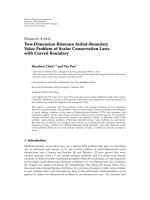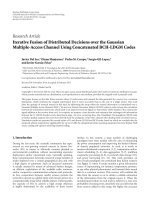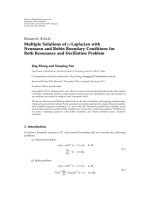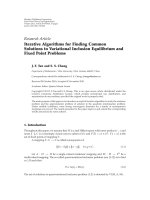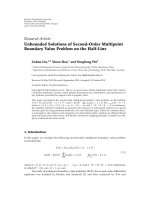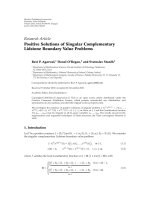Báo cáo hóa học: "Research Article Iterative Solutions of Singular Boundary Value Problems of Third-Order Differential Equation" potx
Bạn đang xem bản rút gọn của tài liệu. Xem và tải ngay bản đầy đủ của tài liệu tại đây (482.03 KB, 10 trang )
Hindawi Publishing Corporation
Boundary Value Problems
Volume 2011, Article ID 483057, 10 pages
doi:10.1155/2011/483057
Research Article
Iterative Solutions of Singular Boundary Value
Problems of Third-Order Differential Equation
Peiguo Zhang
Department of Elementary Education, Heze University, Heze 274000, Shandong, China
Correspondence should be addressed to Peiguo Zhang,
Received 19 January 2011; Revised 20 February 2011; Accepted 6 March 2011
Academic Editor: Kanishka Perera
Copyright q 2011 Peiguo Zhang. This is an open access article distributed under the Creative
Commons Attribution License, which permits unrestricted use, distribution, and reproduction in
any medium, provided the original work is properly cited.
By using the cone theory and the Banach contraction mapping principle, the existence and
uniqueness results are established for singular third-order boundary value problems. The
theorems obtained are very general and complement previous known results.
1. Introduction
Third-order differential equations arise in a variety of different areas of applied mathematics
and physics, such as the deflection of a curved beam having a constant or varying cross
section, three-layer beam, electromagnetic waves, or gravity-driven flows 1. Recently, third-
order boundary value problems have been studied extensively in the literature see, e.g., 2–
13, and their references. In this paper, we consider the following third-order boundary value
problem:
u
t
f
t, u
t
0,t∈
0, 1
,
u
0
u
0
0,u
1
αu
η
,
1.1
where ft, x ∈ C0, 1 × −∞, ∞, −∞, ∞,0<η<1.
Three-point boundary value problems BVPs for short have been also widely studied
because of both practical and theoretical aspects. There have been many papers investigating
the solutions of three-point BVPs, see 2–5, 10, 12 and references therein. Recently, the
existence of solutions of third-order three-point BVP 1.1 has been studied in 2, 3.Guo
et al. 2 show the existence of positive solutions for BVP 1.1 when 1 <α<1/η and
2 Boundary Value Problems
ft, x is separable by using cone expansion-compression fixed point theorem. In 3,the
singular third-order three-point BVP 1.1 is considered under some conditions concerning
the first eigenvalues corresponding to the relevant linear operators, where 1 <α<1/η,
ft, x is separable and is not necessary to be nonnegative, and the existence results of
nontrivial solutions and positive solutions are given by means of the topological degree
theory. Motivated by the above works, we consider the singular third-order three-point BVP
1.1. Here, we give the unique solution of BVP 1.1 under the conditions that αη
/
1and
ft, x is mixed nonmonotone in x and does not need to be separable by using the cone
theory and the Banach contraction mapping principle.
2. Preliminaries
Let J 0, 1, I 0, 1.By2, Lemma 2.1, we have that x is a solution of 1.1 if and only if
x
t
1
0
G
t, s
f
s, x
s
ds, t ∈ I, 2.1
where
G
t, s
1
2
1 − αη
⎧
⎪
⎪
⎪
⎪
⎪
⎪
⎪
⎨
⎪
⎪
⎪
⎪
⎪
⎪
⎪
⎩
1 − αη
s
2
− 2ts
−
1 − α
t
2
s, s ≤ min
η, t
,
αη − 1
t
2
1 − α
t
2
s, t ≤ s ≤ η,
1 − αη
s
2
− 2ts
s − αη
t
2
,η≤ s ≤ t,
s − 1
t
2
, max
η, t
≤ s.
2.2
It is shown in 2 that Gt, s is the Green’s function to −u
0, u0u
00, and
u
1αu
η.
Let
h
t, s
1
s
1 − s
|
G
t, s
|
,
I
1
t
1
0
h
t, s
ds,
I
n1
t
1
0
h
t, s
I
n
s
ds,
n 1, 2,
,
r
G
lim
n →∞
sup
t∈J
I
n
t
−1/n
.
2.3
It is easy to see that rG > 0.
Lemma 2.1 Guo 14, 15. P is generating if and only if there exists a constant τ>0 such that
every element x ∈ CI can be represented in the form x y − z,wherey, z ∈ P and y≤τx,
z≤τx.
Boundary Value Problems 3
3. Singular Third-Order Boundary Value Problem
This section discusses singular third-order boundary value problem 1.1.
Let P {x ∈ CI | xt ≥ 0, ∀ t ∈ 0, 1}. Obviously, P is a normal solid cone of
Banach space CI;by16, Lemma 2.1.2, we have that P is a generating cone in CI.
Theorem 3.1. Suppose that ft, xgt, x, x, and there exist two positive linear bounded operators
B : CI → CI and C : CI → CI with rBC <rG such that for any t ∈
I, x
1
,x
2
,y
1
,y
2
∈
CI, x
1
≥ x
2
, y
1
≤ y
2
, we have
−B
x
1
− x
2
− C
y
2
− y
1
≤ t
1 − t
g
t, x
1
,y
1
− t
1 − t
g
t, x
2
,y
2
≤ B
x
1
− x
2
C
y
2
− y
1
,
3.1
and there exists x
0
,y
0
∈ CI, such that
1
0
t
1 − t
g
t, x
0
t
,y
0
t
dt can converge to σ ∈ R. 3.2
Then 1.1 has a unique solution x
∗
in CI. And moreover, for any x
0
∈ CI, the iterative sequence
x
n
t
1
0
G
t, s
f
t, x
n−1
s
ds
n 1, 2,
3.3
converges to x
∗
n →∞.
Remark 3.2. Recently, in the study of BVP 1.1, almost all the papers have supposed that the
Green’s function Gt, s is nonnegative. However, the scope of α is not limited to 1 <α<1/η
in Theorem 3.1, so, we do not need to suppose that Gt, s is nonnegative.
Remark 3.3. The function f in Theorem 3.1 is not monotone or convex; the conclusions and
the proof used in this paper are different from the known papers in essence.
Proof. It is easy to see that, for any t ∈ J, ht,s can be divided into finite partitioned monotone
and bounded function on 0, 1, and then by 3.2, we have
1
0
G
t, s
g
s, x
0
s
,y
0
s
ds converges to σ
t
∈ R. 3.4
For any x, y ∈ CI,letu |x
0
| |x|, v −|y
0
|−|y|, then u ≥ x
0
,v≤ y
0
,by3.1, we have
−B
u − x
0
t
− C
y
0
− v
t
≤ t
1 − t
g
t, u
t
,v
t
− t
1 − t
g
t, x
0
t
,y
0
t
≤ B
u − x
0
t
C
y
0
− v
t
.
3.5
4 Boundary Value Problems
Hence
t
1 − t
g
t, u
t
,v
t
− t
1 − t
g
t, x
0
t
,y
0
t
≤B
u − x
0
t
C
y
0
− v
t
≤Bu − x
0
Cy
0
− v.
3.6
Following the former inequality, we can easily have
1
0
G
t, s
g
s, u
s
,v
s
− g
s, x
0
s
,y
0
s
ds converges to some element σ
1
t
∈ R;
3.7
thus
1
0
G
t, s
g
s, u
s
,v
s
d
1
0
G
t, s
g
s, x
0
s
,y
0
s
ds
1
0
G
t, s
g
s, u
s
,v
s
− g
s, x
0
s
,y
0
s
ds is converged.
3.8
Similarly, by u ≥ x, v ≤ y and
1
0
Gt, sgs, us,vsds being converged, we have that
1
0
G
t, s
g
s, x
s
,y
s
ds converges to some element σ
2
t
∈ R. 3.9
Define the operator A : CI × CI → CI by
A
x, y
t
1
0
G
t, s
g
s, x
s
,y
s
ds, ∀t ∈ I. 3.10
Then x is the solution of BVP 1.1 if and only if x Ax, x.Let
Sx
t
1
0
h
t, s
Bx
s
ds,
Ty
t
1
0
h
t, s
Cy
s
ds. 3.11
Boundary Value Problems 5
By 3.1 and 3.10, for any x
1
,x
2
,y
1
,y
2
∈ CI, x
1
≥ x
2
, y
1
≤ y
2
, we have
−S
x
1
− x
2
− T
y
2
− y
1
≤ A
x
1
,y
1
− A
x
2
,y
2
≤ S
x
1
− x
2
T
y
2
− y
1
, 3.12
S T
x
t
1
0
h
t, s
B C
x
s
ds,
S T
n1
x
t
1
0
h
t, s
B C
S T
n
x
s
ds
B C
n1
I
n1
t
,n 1, 2, ,
S T
n
≤
B C
n
sup
t∈J
I
n
t
,
r
S T
≤
r
B C
r
G
< 1,
3.13
so we can choose an α, which satisfies lim
n →∞
S T
n
1/n
rS T <α<1, and so there
exists a positive integer n
0
such that
S T
n
<α
n
< 1,n≥ n
0
. 3.14
Since P is a generating cone in CI,fromLemma 2.1, there exists τ>0 such that every
element x ∈ CI can be represented in
x y − z, y, z ∈ P, y≤τx, z≤τx. 3.15
This implies
−
y z
≤ x ≤ y z. 3.16
Let
x
0
inf
{
u|u ∈ P, −u ≤ x ≤ u
}
. 3.17
By 3.16, we know that x
0
is well defined for any x ∈ CI.Itiseasytoverifythat
·
0
is a norm in CI.By3.15–3.17,weget
x
0
≤y z≤2τx, ∀x ∈ C
I
. 3.18
On the other hand, for any u ∈ P which satisfies −u ≤ x ≤ u, we have θ ≤ x u ≤ 2u.
Thus x≤x u −u≤2N 1u, where N denotes the normal constant of P . Since
u is arbitrary, we have
x≤
2N 1
x
0
, ∀x ∈ C
I
. 3.19
6 Boundary Value Problems
It follows from 3.18 and 3.19 that the norms ·
0
and ·are equivalent.
Now, for any x, y ∈ CI and u ∈ P which satisfies −u ≤ x − y ≤ u,let
u
1
1
2
x y − u
,u
2
1
2
x − y u
,u
3
1
2
−x y u
; 3.20
then x ≥ u
1
, y ≥ u
1
, x − u
1
u
2
, y − u
1
u
3
,andu
2
u
3
u.
It follows from 3.12 that
−Su
2
≤ A
x, x
− A
u
1
,x
≤ Su
2
, 3.21
−Su
3
− Tu
2
≤ A
y, u
1
− A
u
1
,x
≤ Su
2
Tu
3
, 3.22
−Tu
3
≤ A
y, u
1
− A
y, y
≤ Tu
3
. 3.23
Subtracting 3.22 from 3.213.23,weobtain
−
S T
u ≤ A
x, x
− A
y, y
≤
S T
u. 3.24
Let
AxAx, x; then we have
−
S T
u ≤
A
x
−
A
y
≤
S T
u. 3.25
As S and T are both positive linear bounded operators, so, S T is a positive linear
bounded operator, and therefore S Tu ∈ P. Hence, by mathematical induction, it is easy
to know that for natural number n
0
in 3.14, we have
−
S T
n
0
u ≤
A
n
0
x
−
A
n
0
y
≤
S T
n
0
u,
S T
n
0
u ∈ P. 3.26
Since S T
n
0
u ∈ P,weseethat
A
n
0
x −
A
n
0
y
0
≤
S T
n
0
u, 3.27
which implies by virtue of the arbitrariness of u that
A
n
0
x −
A
n
0
y
0
≤
S T
n
0
x − y
0
≤ α
n
0
x − y
0
. 3.28
By 0 <α<1, we have 0 ≤ α
n
0
< 1. Thus the Banach contraction mapping principle
implies that
A
n
0
has a unique fixed point x
∗
in CI,andso
A has a unique fixed point
x
∗
in CI; by the definition of
A, A has a unique fixed point x
∗
in CI,thatis,x
∗
is the
unique solution of 1.1. And, for any x
0
∈ CI,letx
n
Ax
n−1
,x
n−1
n 1, 2, ;
we have x
n
− x
∗
0
→ 0 n →∞. By the equivalence of ·
0
and ·again, we get
x
n
− x
∗
→0 n →∞. This completes the proof.
Boundary Value Problems 7
Example 3.4. In this paper, the results apply to a very wide range of functions, we are
following only one example to illustrate.
Consider the following singular third-order boundary value problem:
u
t
k
1
t m
1
1 − t
tan t
u
2
t
k
2
t m
2
2
t
0
p
s, u
s
t tan
1 − s
ds, t ∈ J,
u
0
u
0
0,u
1
αu
η
,
3.29
where k
1
,m
1
,k
2
,m
2
∈ R and there exists M ≥ 0, such that for any t ∈ I, y
1
,y
2
∈ CI, y
1
≤ y
2
,
we have
−M
y
2
− y
1
t
≤ p
t, y
1
t
− p
t, y
2
t
≤ M
y
2
− y
1
t
. 3.30
Applying Theorem 3.1, we can find that 3.29 has a unique solution x
∗
t ∈ C
2
I provided
N max{|m
1
|, |k
1
m
1
|} <rG. And moreover, for any w
0
∈ CI, the iterative sequence
w
n
t
1
0
G
t, s
k
1
s m
1
s tan
1 − s
w
2
n−1
s
k
2
s m
2
2
s
0
p
τ,w
n−1
τ
1 − τ
tan s
dτ
ds,
n 1, 2,
3.31
converges to x
∗
n →∞.
To see that, we put
g
t, x
t
,y
t
k
1
t m
1
1 − t
tan t
x
2
t
k
2
t m
2
2
t
0
p
s, y
s
t tan
1 − s
ds,
Bx
t
Nx
t
,
Cy
t
M
t
0
y
s
ds.
3.32
Then 3.1 is satisfied for any t ∈ I, x
1
,x
2
,y
1
,y
2
∈ CI, x
1
≥ x
2
,andy
1
≤ y
2
.
In fact, if x
1
tx
2
t, then
t
1 − t
g
t, x
1
t
,y
1
t
− t
1 − t
g
t, x
2
t
,y
2
t
≤
k
1
t m
1
x
2
1
t
k
2
t m
2
2
−
k
1
t m
1
x
2
2
t
k
2
t m
2
2
t
0
p
s, y
1
s
− p
s, y
2
s
ds
t
0
p
s, y
1
s
− p
s, y
2
s
ds
≤
t
0
M
y
2
s
− y
1
s
ds
B
x
1
− x
2
t
C
y
2
− y
1
t
.
3.33
8 Boundary Value Problems
If x
1
t >x
2
t, then
t
1 − t
g
t, x
1
t
,y
1
t
− t
1 − t
g
t, x
2
t
,y
2
t
≤
k
1
t m
1
x
2
1
t
k
2
t m
2
2
−
k
1
t m
1
x
2
2
t
k
2
t m
2
2
t
0
p
s, y
1
s
− p
s, y
2
s
ds
k
1
t m
1
x
2
1
t
− x
2
2
t
x
2
1
t
k
2
t m
2
2
x
2
2
t
k
2
t m
2
2
t
0
p
s, y
1
s
− p
s, y
2
s
ds
≤
k
1
t m
1
|
x
1
t
|
−
|
x
2
t
|
t
0
M
y
2
s
− y
1
s
ds
≤
|
k
1
t m
1
|
x
1
t
− x
2
t
M
t
0
y
2
s
− y
1
s
ds
≤ B
x
1
− x
2
t
C
y
2
− y
1
t
.
3.34
Similarly,
t
1 − t
g
t, x
1
t
,y
1
t
− t
1 − t
g
t, x
2
t
,y
2
t
≥−B
x
1
− x
2
t
− C
y
2
− y
1
t
. 3.35
Next, for any t ∈ I,by3.30 and 3.32,weget
Tu
t
≤Mt
u
c
. 3.36
Then, from 3.32 and 3.36, we have
T
2
u
t
≤ M
t
0
Tu
s
ds ≤ M
u
c
t
0
sds
M
2
t
2
2!
u
c
, ∀t ∈ I, 3.37
so it is easy to know by induction, for any n,weget
T
n
u
t
≤
M
n
t
n
n!
u
c
, ∀t ∈ I; 3.38
thus
T
n
u
max
t∈I
T
n
u
t
≤
M
n
t
n
n!
u
c
, 3.39
Boundary Value Problems 9
so
r
T
lim
n →∞
T
n
1/n
0. 3.40
then we get
r
B C
≤ r
B
r
C
N 0 <r
G
. 3.41
Let x
0
y
0
1; then
1
0
t
1 − t
g
t, x
0
t
,y
0
t
dt is converged. 3.42
Thus all conditions i n Theorem 3.1 are satisfied.
Acknowledgment
The author is grateful to the referees for valuable suggestions and comments.
References
1 M. Gregus, “Third order linear Differential equations,” in Mathematics and Its Applications, Reidel,
Dordrecht, the Netherlands, 1987.
2 L J. Guo, J P. Sun, and Y H. Zhao, “Existence of positive solutions for nonlinear third-order three-
point boundary value problems,” Nonlinear Analysis. Theory, Methods & Applications, vol. 68, no. 10,
pp. 3151–3158, 2008.
3 F. Wang and Y. Cui, “On the existence of solutions for singular boundary value problem of third-order
differential equations,” Mathematica Slovaca, vol. 60, no. 4, pp. 485–494, 2010.
4 Y. Sun, “Positive solutions for third-order three-point nonhomogeneous boundary value problems,”
Applied Mathematics Letters, vol. 22, no. 1, pp. 45–51, 2009.
5 J. R. Graef and J. R. L. Webb, “Third order boundary value problems with nonlocal boundary
conditions,” Nonlinear Analysis. Theory, Methods & Applications, vol. 71, no. 5-6, pp. 1542–1551, 2009.
6 Z. Liu, L. Debnath, and S. M. Kang, “Existence of monotone positive solutions to a third order two-
point generalized right focal boundary value problem,” Computers & Mathematics with Applications,
vol. 55, no. 3, pp. 356–367, 2008.
7 F. M. Minh
´
os, “On some third order nonlinear boundary value problems: existence, location and
multiplicity results,” Journal of Mathematical Analysis and Applications, vol. 339, no. 2, pp. 1342–1353,
2008.
8 B. Hopkins and N. Kosmatov, “Third-order boundary value problems with sign-changing solutions,”
Nonlinear Analysis. Theory, Methods & Applications, vol. 67, no. 1, pp. 126–137, 2007.
9 Q. Yao, “Successive iteration of positive solution for a discontinuous third-order boundary value
problem,” Computers & Mathematics with Applications, vol. 53, no. 5, pp. 741–749, 2007.
10 A. Boucherif and N. Al-Malki, “Nonlinear three-point third-order boundary value problems,” Applied
Mathematics and Computation, vol. 190, no. 2, pp. 1168–1177, 2007.
11 S. Li, “Positive solutions of nonlinear singular third-order two-point boundary value problem,”
Journal of Mathematical Analysis and Applications, vol. 323, no. 1, pp. 413–425, 2006.
12 Y. Sun, “Positive solutions of singular third-order three-point boundary value problem,” Journal of
Mathematical Analysis and Applications, vol. 306, no. 2, pp. 589–603, 2005.
10 Boundary Value Problems
13 Z. Du, W. Ge, and X. Lin, “Existence of solutions for a class of third-order nonlinear boundary value
problems,” Journal of Mathematical Analysis and Applications, vol. 294, no. 1, pp. 104–112, 2004.
14 D. Guo, Semi-Ordered Method in Nonlinear Analysis, Shandong Scientific Technical Press, Jinan, China,
2000.
15 D. J. Guo and V. Lakshmikantham, Nonlinear Problems in Abstract Cones, vol. 5 of Notes and Reports in
Mathematics in Science and Engineering, Academic Press, Boston, Mass, USA, 1988.
16 D. Guo, V. Lakshmikantham, and X. Liu, Nonlinear Integral Equations in Abstract Spaces, vol. 373 of
Mathematics and Its Applications, Kluwer Academic Publishers, Dordrecht, The Netherlands, 1996.

